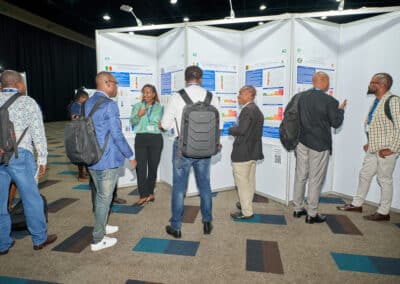In response to a request from Zimbabwe’s Ministry of Health and Child Care (MoHCC), the HIV Coverage, Quality, and Impact Network (CQUIN) supported a study exploring barriers and facilitators to male engagement in community antiretroviral therapy (ART) refill groups (CARGs). The project is part of CQUIN’s portfolio of catalytic projects, which generate knowledge to facilitate the scale-up of HIV differentiated service delivery (DSD) in sub-Saharan Africa.
“We conducted this study because of concerns that men aren’t as involved in CARGs as women,” said Tsitsi Apollo, MD, deputy director, AIDS/STIs at MoHCC. “This study presented an opportunity for us to address the key issues around why men don’t join CARGs, such as confidentiality and access.”
We sat down to talk with Joanne Mantell, Ph.D., one of the study co-investigators, about the preliminary findings and how they might influence HIV service delivery in Zimbabwe and beyond. Dr. Mantell is a research scientist at the HIV Center for Clinical and Behavioral Studies at the New York State Psychiatric Institute and Columbia University, and a professor of Clinical Psychology (in Psychiatry) at the Columbia University Medical Center.
How did the male engagement study start and what does it entail?
The Zimbabwe MoHCC has committed to scaling up HIV treatment to all individuals living with HIV. One way of achieving this is to scale up DSD, which can both improve patient satisfaction and decrease patient volume at health facilities. One of the DSD models in Zimbabwe’s national guidelines is the CARG: a self-formed group of stable ART patients from the same geographic area. Members of the group rotate responsibility for collecting medication refills from the clinic for all participants, which reduces the number of facility visits for each person.
These are being scaled up, but to date, most CARG members are women. There are a significant number of Zimbabwean men who are enrolled in HIV treatment, but many weren’t participating in these groups. This study sought to understand the facilitators and barriers to male involvement in order to improve service delivery.
The study team, which included co-investigators from ICAP and MoHCC, selected a few rural health facilities to see what was going on. We used a mixed-methods approach, including focus-group discussions and key informant interviews, and asked questions about barriers and facilitators to HIV care, with specific questions about barriers and facilitators to participation in CARGs. We conducted 16 focus groups with HIV-positive men in and out of CARGs, and four focus groups with HIV-positive women who were in CARGs.
We supplemented the 20 focus groups with 45 in-depth interviews with policy-makers, implementing partners, health care providers, and community members. It took three months for our ICAP in Zimbabwe team to complete the interviews and focus groups. The initial data analysis explored responses to key questions from both focus groups and interviews. Some questions were the same across all cadres of participants, but we also had tailored questions for particular groups. We are interested in identifying the similarities and differences across these different cadres of participants.

Dr. Mantell (left) works with a member of the study team, Dr. Tsitsi Masavaure, during data collection training at the ICAP offices in Harare, July 2017.
What have you found so far?
Some men do join these groups, and they appreciate the adherence support and convenience. Men also noted that the CARG model saves them money, since they don’t need to travel to the clinic as often. What we are hearing from other men is that some of what they want or expect may not be exactly aligned with the original purpose of CARGs. This is particularly true when it comes to income generation. Some of the men we spoke to said they want to see income generation tied to these groups. They feel that if they’re not working full-time, they want to feel useful. It taps into their ideas of what a man should be—a provider for his family.
We also found persistent concerns about confidentiality, privacy, and stigma. CARGs are supposed to decrease stigma by providing access to peers and informal psychosocial support, but our informants revealed that they could also increase stigma. If you’re the focal person taking the medication-distribution kits from the clinic back to the community, you may find that you’re distributing them in an open area where people can walk by and see you, and start asking questions. This could reveal your HIV status in the community.
Another issue we heard was fear of clinical staff gossiping about people’s HIV status. Of course, we would expect this not to happen, but it certainly could. That suggests to me that implementers need to emphasize professionalism and patient confidentiality when they conduct refresher trainings for providers.
Did anything that you found surprise you?
I didn’t think these CARGs could increase stigma. However, this has come up in other studies unrelated to CARGs. In Lesotho, for example, we saw that men preferred to have people from outside of their communities conduct home testing, as a way of ensuring confidentiality. This is particularly true in rural areas, whereas in urban areas, anonymity is much easier to preserve.
How do you think the results fit into the overall context of DSD scale-up?
I hope that what we have learned can be incorporated into CARG models. Perhaps there could be an emphasis on continued training of providers about issues related to sensitivities of disclosing someone’s HIV status inadvertently (not intentionally). Income-generation is a larger issue to consider. Participants also mentioned the need for male-only groups or workplace-based groups (e.g., in mining areas)
When it comes to DSD models, one size does not fit all. One model is not going to work for everyone, but it might be worthwhile to compare the effectiveness of each model. This is especially true when evaluating resource intensity.
Do you anticipate these results informing policy-making decisions, or even helping to shape similar studies in other countries?
Our findings could guide other countries that have the same, or similar, models. Having data to document what the barriers are to participation in any of these models—whether it’s appointment spacing, community- or facility-based ARV distribution—is definitely important. Gathering quantitative data is also important. I would recommend using a sequential quantitative-qualitative approach or mixed methods, in one study. You could then identify what the issues are from the qualitative data, the scope of these barriers, and how frequently they occur.
What do you hope the findings from this study accomplish?
I hope the results can be incorporated into HIV treatment programs in innovative ways that enable and empower more men to join CARGs and other DSD models, with the goal of improving the quality of HIV treatment for patients, as well as relieving the burden on clinical staff.
This story is part of a series focused on the evolution of the CQUIN network, and countries’ progress in improving differentiated service delivery. To follow this story and others, sign up for the network’s monthly newsletter.






